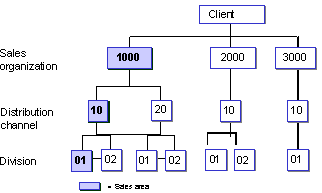INQUIRY
VA11 is the T-code for inquiry and related tables are VBAK, VBAP.Once inquiry is done customer requests quotation.
QUOTATION
T-code for quotation in VA21, tables are VBAK, VBAP.After quotation flow goes for purchase order.
PURCHASE ORDER
Purchase order t-code is ME21N, related tables are EKKO, EKPO.Based on purchase order sales order will be created.
SALES ORDER
Sales order t-code is VA01, related tables are VBAK, VBAP. Once sales order is created, delivery will be done.
DELIVERY
T-code for delivery order is VL01N, tables are LIKP, LIPS. Next the goods should be dlivered through shipping
SHIPPING
Shipping t-code is VT01, related tables are VTTK, VTTP.Once goods are shipped, go for billing.
BILLING
Billing t-code is VF01, tables are VBRK,VBRP. Every bill has invoice...next provide invoice.
INVOICE
Invoice t-code is VF21, related tables are VBRK, VBRP.Invoice end of sales flow.
=================================================================================
Enhancement Scenario:
- Addition of tab , Item Level : VF01 SD Invoice
- http://wiki.scn.sap.com/wiki/pages/viewpage.action?pageId=235803375
- Step 1 : Got to SE11 table VBRP
- Step 2 : Add a Z structure to this table with one field Zadd for example.
- Step 3 : Create a Z program and write code to that program.
- Step 4 : add layout in the screen of this Z program. use structure field.
- Step 5 : Go to SE80 and give th eprogram name of the VF01 Transaction. (SAPMV60A)
- Step 6 : Find enhancement point and implement it with following logic:
- Implement CUST_ITEM_ACTIVATE
=================================================================================
VOFM :
- VOFM routines are ABAP code written in Forms.
- VOFM provides the user with the benefit of choosing from one of the standard delivered by SAP or writing their own.
- VOFM basically is for the implementation team and not for the end user.
- Copying Requirements : This is provided by SAP to support SD and logistics requirements.
- In each area of VOFM, SAP delivers routines using the name space from 1 to 599.
- SAP customers
can create their own VOFM routines using the name space from 600 to 999.
- New VOFM routines created at a customer site are not overwritten by a software upgrade.
- http://www.newtosap.info/2014/01/vofm-routinesa-short-guide.html
- VOFM routines can be used to propose/alter the business process and it can be triggered for particular condition. Ex: Pricing condition ZCIL which will trigger the routine whenever it’s used.
- There are various categories in VOFM like Data Transfer, Requirements, Formulae’s etc. Depending upon the category, the routine or exit will be called. Ex: any routine done in Formula’s category will be triggered during the computation of formula of a particular pricing condition. One has to choose the correct category and create a new routine.
- V/08 for assigning routine number to the required pricing procedure.
- http://www.saptechsolutions.com/pdf/InsideVOFM.pdf
=====================================================================
Condition Record:
- The following new transactions are offered:
- Create conditions (transaction VK31)
- Create conditions with reference (transaction VK34)
- Change conditions (VK32)
- Display conditions (VK33)
========================================================================Enterprise structure in SD :
- Client - TATA
- Company Code - TCS
- Sales Area :
- Sales Organisation (Delhi)
- Distribution channel (online, retail store)
- Division

- Plant
- Shipping Point
- Loading Point
Element of SD Org Structure:
- Sales Organization
- Distribution Channel
- Division
- Sales Office
- Sales Group
- Internal structure:
- Sales Office
- Sales Group
- Sales Person
========================================================================
1. Creation of Sales Order - VA01
2. Creation of Outbound Delivery - VL01N
Shipment process will start form here
3. Creation of Condition Record for Forwarding Agent, : VK11
- Give condition type (we can create them by copy standard)
- Give the service agent and Tf zone point of dep.
- give the Amount unit and save it .
Service Agent used to calculate net amount in the Shipment cost doc.
4. Creation of Shipment Document : VT01N
(Note- Shipment document we can create with reference to outbound delivery before PGI or after PGI)
- A shipment document will be created against one or more delivery.
5. Creation of Shipment Cost Document VI01
A) PO and service entry sheet will be created automatically by the system.
6. Enter Vendor’s Invoice (Invoice receipt and verification). MIRO
========================================================================

